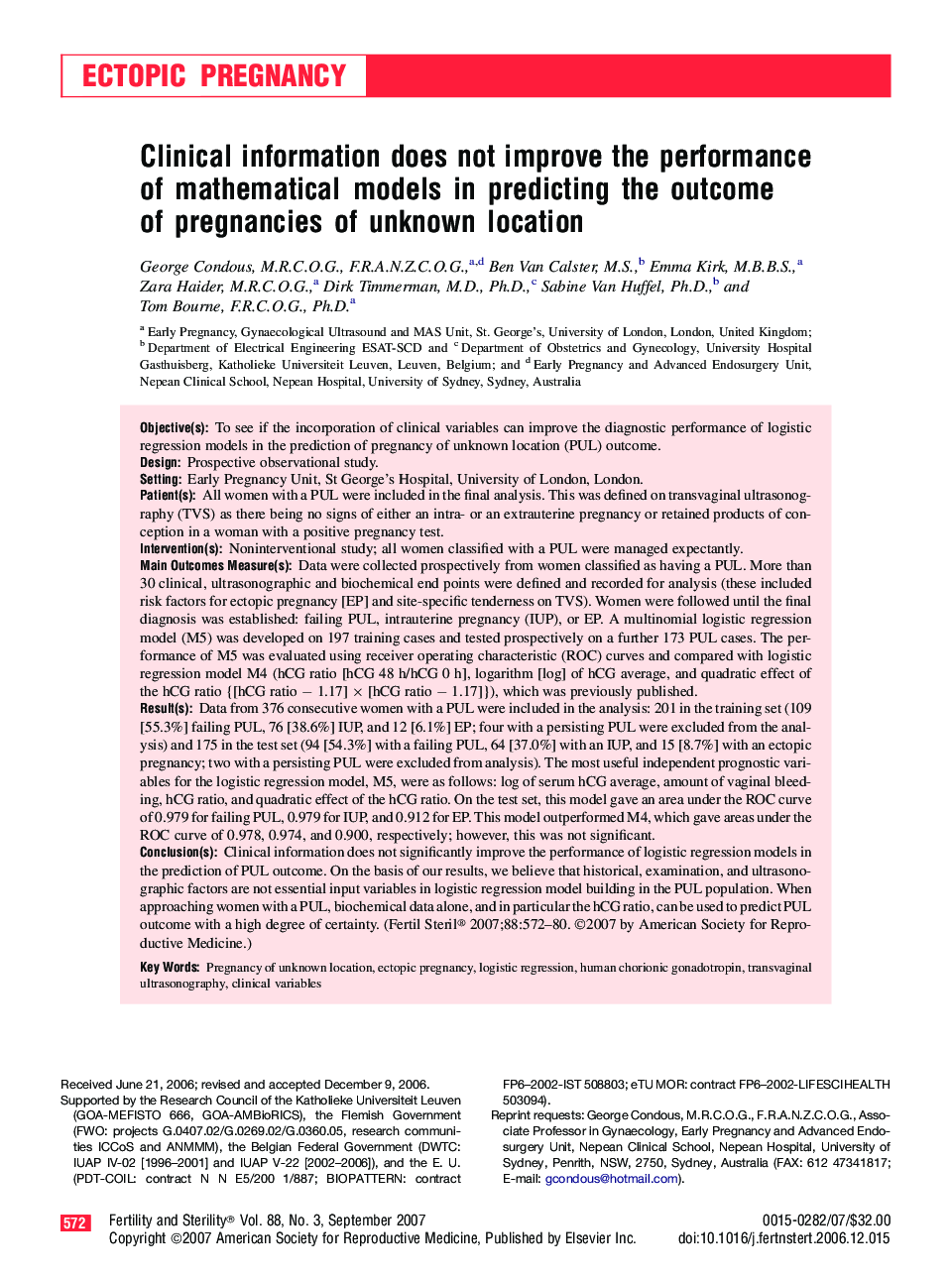| کد مقاله | کد نشریه | سال انتشار | مقاله انگلیسی | نسخه تمام متن |
|---|---|---|---|---|
| 3939717 | 1253568 | 2007 | 9 صفحه PDF | دانلود رایگان |

Objective(s)To see if the incorporation of clinical variables can improve the diagnostic performance of logistic regression models in the prediction of pregnancy of unknown location (PUL) outcome.DesignProspective observational study.SettingEarly Pregnancy Unit, St George's Hospital, University of London, London.Patient(s)All women with a PUL were included in the final analysis. This was defined on transvaginal ultrasonography (TVS) as there being no signs of either an intra- or an extrauterine pregnancy or retained products of conception in a woman with a positive pregnancy test.Intervention(s)Noninterventional study; all women classified with a PUL were managed expectantly.Main Outcomes Measure(s)Data were collected prospectively from women classified as having a PUL. More than 30 clinical, ultrasonographic and biochemical end points were defined and recorded for analysis (these included risk factors for ectopic pregnancy [EP] and site-specific tenderness on TVS). Women were followed until the final diagnosis was established: failing PUL, intrauterine pregnancy (IUP), or EP. A multinomial logistic regression model (M5) was developed on 197 training cases and tested prospectively on a further 173 PUL cases. The performance of M5 was evaluated using receiver operating characteristic (ROC) curves and compared with logistic regression model M4 (hCG ratio [hCG 48 h/hCG 0 h], logarithm [log] of hCG average, and quadratic effect of the hCG ratio {[hCG ratio − 1.17] × [hCG ratio − 1.17]}), which was previously published.Result(s)Data from 376 consecutive women with a PUL were included in the analysis: 201 in the training set (109 [55.3%] failing PUL, 76 [38.6%] IUP, and 12 [6.1%] EP; four with a persisting PUL were excluded from the analysis) and 175 in the test set (94 [54.3%] with a failing PUL, 64 [37.0%] with an IUP, and 15 [8.7%] with an ectopic pregnancy; two with a persisting PUL were excluded from analysis). The most useful independent prognostic variables for the logistic regression model, M5, were as follows: log of serum hCG average, amount of vaginal bleeding, hCG ratio, and quadratic effect of the hCG ratio. On the test set, this model gave an area under the ROC curve of 0.979 for failing PUL, 0.979 for IUP, and 0.912 for EP. This model outperformed M4, which gave areas under the ROC curve of 0.978, 0.974, and 0.900, respectively; however, this was not significant.Conclusion(s)Clinical information does not significantly improve the performance of logistic regression models in the prediction of PUL outcome. On the basis of our results, we believe that historical, examination, and ultrasonographic factors are not essential input variables in logistic regression model building in the PUL population. When approaching women with a PUL, biochemical data alone, and in particular the hCG ratio, can be used to predict PUL outcome with a high degree of certainty.
Journal: Fertility and Sterility - Volume 88, Issue 3, September 2007, Pages 572–580